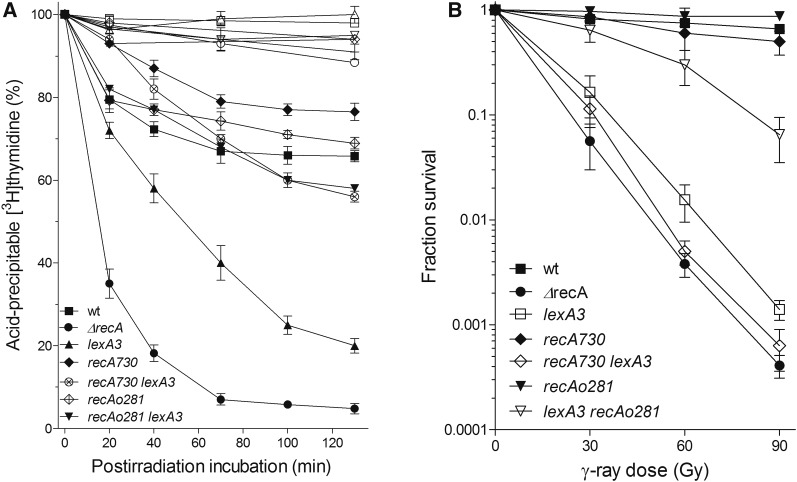Figure 1.
(A) DNA degradation in γ-irradiated E. coli depends on RecA protein concentration and its rate of association with ssDNA. Bacterial cultures were divided into two counterparts; one served as a control (open symbols), while the other was irradiated with 400 Gy (closed symbols). The cultures contained [3H]thymidine-labeled chromosome; kinetics of their degradation were monitored during incubation at 37°. AB1157 (□,▪); ∆recA (○,●); lexA3 (▵,▴); recAo281 (+, ); lexA3 recAo281 (▿,▾); recA730 (◊,♦); and recA730 lexA3 (×,⊗). Each value is a mean of three independent experiments, with error bars representing SD. (B) Survival of γ-irradiated bacteria. Wild-type strain AB1157 (▪) and its recA (●), lexA3 (h), recAo281 (▾), lexA3 recAo281 (▿), recA730 (♦), and recA730 lexA3 (◊) derivatives. Fraction survival is given as a fraction of the unirradiated control. Each value is a mean of three independent experiments, with error bars representing SD. ssDNA, single-stranded DNA; wt, wild-type.
); lexA3 recAo281 (▿,▾); recA730 (◊,♦); and recA730 lexA3 (×,⊗). Each value is a mean of three independent experiments, with error bars representing SD. (B) Survival of γ-irradiated bacteria. Wild-type strain AB1157 (▪) and its recA (●), lexA3 (h), recAo281 (▾), lexA3 recAo281 (▿), recA730 (♦), and recA730 lexA3 (◊) derivatives. Fraction survival is given as a fraction of the unirradiated control. Each value is a mean of three independent experiments, with error bars representing SD. ssDNA, single-stranded DNA; wt, wild-type.

